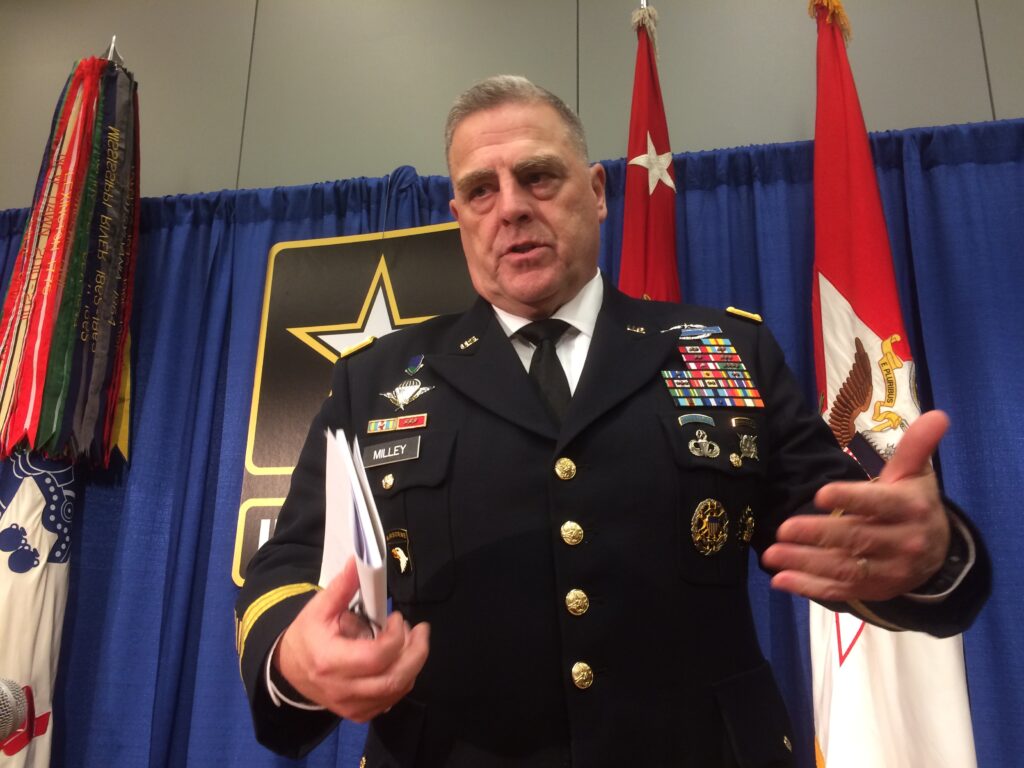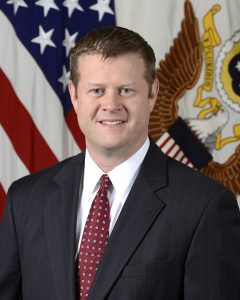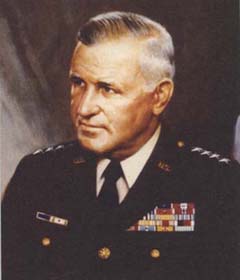
Gen. Mark Milley
AUSA: The Army will start buying weapons the way Special Operations does, Army Chief of Staff Mark Milley told reporters here, bringing different specialists together in one streamlined team. The often-insular Army is also studying the other services, Milley said, particularly the rapid development of the nuclear Navy under legendary Adm. Hyman Rickover. A three-star officer, Lt. Gen. Ed Cardon, is currently developing detailed options, and Milley hopes to stand up “this new command” by summer 2018.
[click here for more detail on the reforms, now endorsed by Sen. John McCain]

Acting Secretary of the Army Ryan McCarthy
The primary objective: Infuse real-world combat experience into every step of the process. “Warfighters have to be intimately involved from the front end, (in) Milestone A (research) and B (development),” Acting Secretary of the Army Ryan McCarthy told a different group of reporters. That’s in contrast to the current “bifurcated” system, in which combat veterans, requirement writers for what new equipment must do, the program managers who actually build things, and the logisticians who keep them running are segregated in different bureaucracies.
The new system will draw on the experience of Special Operations Command and other small, streamlined organizations – such as the Army’s own Rapid Capabilities Office (RCO) and Rapid Equipping Force (REF). They will try to scale that up to the Big Army, McCarthy said. For each top priority program, a former combat brigade commander will lead a “cross functional team” of concept and requirements developers, program managers, testers, logisticians, and so on.
McCarthy emphasized that the Army isn’t asking for new force structure, just reorganizing what it has, and legally mandated reporting requirements will remain in place. Program managers will participate on the new teams, for example, but they’ll still answer to the Assistant Secretary of the Army for Acquisition, Technology, and Logistics (ASAALT). Will the Army need new legal authorities or relief from existing statue? “I don’t know,” McCarthy said frankly, but he’s already been talking with legislators and their staff.
One change defense contractors will appreciate: McCarthy is working with the Undersecretary of Defense for Acquisition, Ellen Lord, to change an unpopular policy on companies’ Independent Research And Development expenses. The intent, he told a formal press conference here, is to give companies incentives to spend their own money in IRAD, which benefits the troops, instead of sitting on cash and buying back their stock, which doesn’t.

Training & Doctrine Command (TRADOC) headquarters on Fort Eustis, Virginia
New Model Army
All told, it’s an all-out assault on the slowest and most sclerotic of military bureaucracies (which is really saying something), the Army’s acquisition system. Milley said it would be “the largest reengineering of the institutional Army in four decades.”
Milley repeatedly emphasized that 40-year figure. Why? He’s referring to the 1973 reform by his famed predecessor, Gen. Creighton Abrams, that established a separate Training & Doctrine Command (TRADOC) to oversee all training, write all doctrinal manuals, and develop requirements. Once TRADOC writes requirements, however, they’re handed to Army Materiel Command (AMC) and the ASAALT, who actually research, develop, buy, field, and sustain the equipment in question.

Gen. Creighton Abrams, Army Chief of Staff 1972-1974
Getting requirements right is difficult for any military organization, but only the Army has to struggle with such a stark bureaucratic divide. TRADOC leaders have publicly acknowledged the process must change. One plausible rumor we’ve heard is that a new “Modernization Command” will be built by combining TRADOC’s Army Capabilities Integration Center (ARCIC) and AMC’s Research & Development Command (RDECOM), probably along with elements of Army Test & Evaluation Command (ATEC).
The proposed reform is outlined very vaguely in a memo co-signed by Gen. Milley and Sec. McCarthy, first reported by our colleague Patrick Tucker. “Our processes are staff-centric and often stove-piped, which inhibits integration within our across programs. Our requirements process is slow and overly bureaucratic,” the memo says. To fix this, “our Army will establish unity of command and unity of effort that consolidates the modernization process under one roof.”
At a press conference here, Milley and McCarthy declined to divulge many details of the plan. The reorganization scheme is being developed by a task force under Lt. Gen. Ed Cardon, who reports back in 120 days. But Milley shared more of his thinking to reporters who caught him on his way out, to the visible frustration of the aides trying to keep him on schedule:
“If you want to see the genesis of the model that we’re thinking about, go take a look at how SOCOM does their thing, because that’s where we got a lot of the ideas,” Milley said. “We looked at the way the Air Force does it, the Navy does it, (including) the navy in the nuclear environment, y’know under Rickover, (and) we went out to industry… we looked at all of that and tried to take best practices.”
“We’ve got to streamline, we’ve got to rationalize,” Milley said. “Right now, the Army’s structure — the institution, the processes, the organization (is) not coherent to deliver effective capabilities for the future.”
“With a few exceptions like the ARCO (Army Rapid Capabilities Office) and the REF (Rapid Equipping Force), we’re basically a left-right-left, step-by-step process going from an idea, establishing a requirement, writing up a big requirements document, and then vetting it through multiple steps,” Milley said. “It takes 10, 20 years to go from idea to delivery of a capability. You just can’t operate like that in today’s world. You just can’t do it. It’s got to be faster, it’s got to be streamlined, it’s got to be more coherent, and we’ve got to kind of bring it all together.”
Sullivan says Ukraine supplemental should cover all of 2024, long-range ATACMS now in Ukraine
“We now have a significant number of ATACMS coming off their production line and entering US stocks,” Jake Sullivan said today. “And as a result, we can move forward with providing the ATACMS while also sustaining the readiness of the US armed forces.”


























